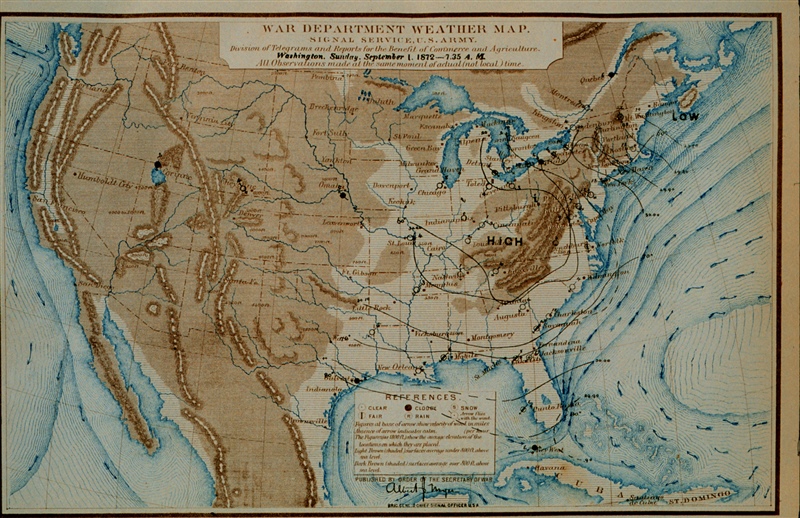The First Synchronized Weather Observations - National Weather Service Heritage

The First Synchronized Weather Observations
By NWS Heritage Projects StaffFollowing the passage of a joint resolution of Congress on February 9, 1870, which authorized the Secretary of War to create a national weather service, the Chief Signal Officer of the U.S. Army Signal Service was charged with the supervision of the new organization. In his 1870 report to the Secretary, Gen. Albert J. Myer reported on the challenges of setting up the new agency:
The duty thus imposed on the Department was one for which the popular mind had been in some degree prepared by the recorded labors and the theories of meteorologists, and by detached efforts, made at different times to accomplish the ends in view, but without fixed organizations and with necessarily contracted plans. The undertaking, upon a scale of such magnitude as that provided by the law, had not been generally contemplated even in this country.
After careful analysis, it was determined that synchronous weather observations would be taken 3 times a day (around 8 am, 6 pm, and midnight, Washington D.C. time). The times were selected to work around peak traffic periods on telegraph lines. Working with the telegraph companies to make the observations a higher priority, it was hoped that the time from collection to reception in Washington would not exceed one hour.
A total of 25 stations were designated to take observations and reports. Each station was equipped with a barometer, a thermometer, a hygrometer, an anemometer, an anemoscope to show wind direction, and a pluviometer (rain gauge). The instruments were to be read in a particular order of precedence, with reductions made for temperature and elevation as needed. Observations would be taken 3 times a day, at 8-hour intervals. The idea in the timing and placement was that most storms would not progress more than 300 miles during that time frame. The network was set that additional stations may be added as needed. Arrangements for sending the observations via telegraph also had to be considered. On October 10th, 25 observer sergeants were ordered to take their posts at these stations, and all had reported by the 16th.
On November 1, at 7:35 am, the first observations were taken. Washington received the reports from the following 25 stations:
| Location | Barometer | Temperature | Wind | Pressure of Wind (lb./sq. ft) |
Cloud cover | State of Weather |
|---|---|---|---|---|---|---|
| Augusta | 30.42" | 46 F | Calm | N/A | N/A | Clear |
| Boston | 29.65" | 44 F | W 3 mph (Gentle) | 0.04 | N/A | Fair |
| Buffalo | 29.38" | 40 F | W 7 mph (Light) | 0.24 | N/A | Clear |
| Cheyenne | 27.12" | 45 F | W 13 mph (Brisk) | 0.83 | N/A | Clear |
| Chicago | 30.03" | 40 F | SW 14 mph (Brisk) | 0.75 | N/A | Clear |
| Cincinnati | 29.52" | 40 F | SE 5 mph (Light) | 0.12 | 1/4 | Clear |
| Cleveland | 30.09" | 35 F | SE 12 mph (Brisk) | 0.83 | N/A | Clear |
|
Detroit |
29.84" | 37 F | S 5 mph (Light) | 0.12 | N/A | Clear |
| Duluth | 28.99" | 37 F | SW 4 mph (Light) | 0.07 | N/A | N/A |
| Key West | 29.98" | 75 F | E 4 mph (Gentle) | 0.07 | 4/4 | Cloudy |
| Lake City, FL | 30.05" | 62 F | Calm | 0.00 | 1/4 | Clear |
| Milwaukee | 30.07" | 42 F | W 12 mph (Brisk) | 0.83 | N/A | Clear |
| Mobile | 30.17" | 50 F | Calm | N/A | N/A | Clear |
| Montgomery | 30.18" | 47 F | Calm | N/A | N/A | Clear |
| Nashville | 30.08" | 51 F | N 2 mph (Gentle) | 0.02 | 1/2 | Fair |
| New Orleans | 30.08" | 64 F | NE 3 mph (Gentle) | 0.04 | 1/4 | Fair |
| New York | 30.12" | 45 F | Calm | 0.00 | N/A | Clear |
| Omaha | 29.32" | 36 F | S 4 mph (Gentle) | 0.07 | N/A | Clear |
| Oswego, NY | 29.94" | 44 F | W 20 mph (Very Brisk) | 1.96 | N/A | Fair |
| Pittsburgh | 29.32" | 38 F | S 3 mph (Gentle) | 0.04 | 1/4 | Fair |
| Rochester, NY | 30.03" | 40 F | W 7 mph (Light) | 0.24 | 3/4 | Fair |
| St. Louis | 29.91" | 45 F | SE 7 mph (Light) | 0.24 | N/A | Clear |
| St. Paul | 29.50" | 38 F | E 1 mph (Very Light) | 0.01 | N/A | Clear |
| Toledo | 30.00" | 38 F | S 2 mph (Gentle) | 0.02 | N/A | Clear |
| Washington | 30.03" | 45 F | W 1 mph (Light) | 0.01 | 1/4 | Fair |
For more information on the setup of the observation network, view the 1870 and 1871 editions of the Annual Report of the Chief Signal Officer, available at the following web page: https://library.noaa.gov/Collections/Digital-Docs/Signa-Corps-WB-Annual
Additional Reading and Resources
